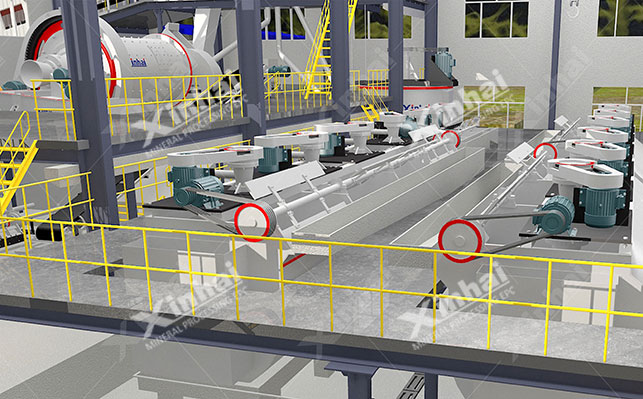
15311826613
Click to add WeChatCarbon-containing gold ore is a difficult-to-select gold ore. As easy-to-select high-grade gold ore has become increasingly scarce, this difficult-to-select gold has become the target of development for major investors. There are many methods for beneficiating carbon-containing gold ores, and the specific process depends on the properties of the ore. This article takes a carbon-containing gold ore as an example to introduce its flotation process.
The ore is an altered silicified breccia gold ore. The main gold-bearing mineral in the ore is carbonaceous material, and the gold distribution rate in carbon is 57%; other minerals account for 43% of the gold. The embedded particle size of gold in the ore is extremely fine, and it is mostly coexisting with other minerals. The main metal minerals are gold and silver, accompanied by mercury, antimony, etc., and a small amount of arsenic; the gangue minerals are mainly quartz, followed by calcite, mica, etc. The carbon-containing gold ore has a high carbon content and is the main carrier of gold.

Because the ore has a high carbon content and is the main carrier mineral of gold, combined with multiple mineral processing test analysis, it is finally determined to adopt the process of preferential carbon flotation-tailings flotation gold.

The carbon in the gold ore is brittle and easy to muddy, and it is the main carrier mineral of gold. During the flotation process, carbon will absorb a large amount of flotation reagents, resulting in excessive reagent consumption, and no matter how much collector is used, the gold recovery rate and concentrate grade are not high. Therefore, it is necessary to first use the priority flotation method to remove carbon.
The process is as follows: Due to the brittleness of carbon, before flotation, in order to reduce excessive wear and achieve the separation effect, a conventional grinding can be used. The suitable fine particles are -200 mesh accounting for 55%. When carbon is preferentially floated, kerosene and No. 2 oil are used as reagents, and the amount of kerosene is 70g/t. Carbon can be effectively removed after one roughing, one fine selection, and one scavenging.
For the tailings after carbon flotation, gold is flotated. The process is to grind the tailings into two stages to -200 mesh accounting for 80%, and complete the gold separation after one roughing, one fine selection, and one scavenging process. In the process, since most of the gold carriers are carbonaceous materials, followed by sulfides, CuSO4 is used to activate them, which is helpful for gold recovery. Moreover, the gold in the ore is finely embedded, and the ore must be ground to a certain fineness to dissociate the gold mineral monomer. Therefore, the collector No. 38 yellow medicine dosage is 200g/t, butyl ammonium black medicine is 80g/t, lime is used for slurry adjustment, pH=7 to complete flotation, and finally a concentrate with a gold grade of 28.80g/t is obtained, and the gold recovery rate is 41.22%.

The above is an introduction to a carbon-containing gold ore flotation process process. In the actual gold selection process, the gold ore beneficiation process customization and reagent selection must meet the characteristics of the ore to effectively obtain high-grade gold concentrate. Therefore, it is recommended to conduct a beneficiation test first, and design a suitable gold ore beneficiation process through test analysis. At the same time, a complete set of gold ore beneficiation equipment can be designed according to the gold ore process. If you have any needs, please consult Xinhai Mining Equipment, which can provide gold ore beneficiation and full industrial chain services. Hotline: 15311826613!